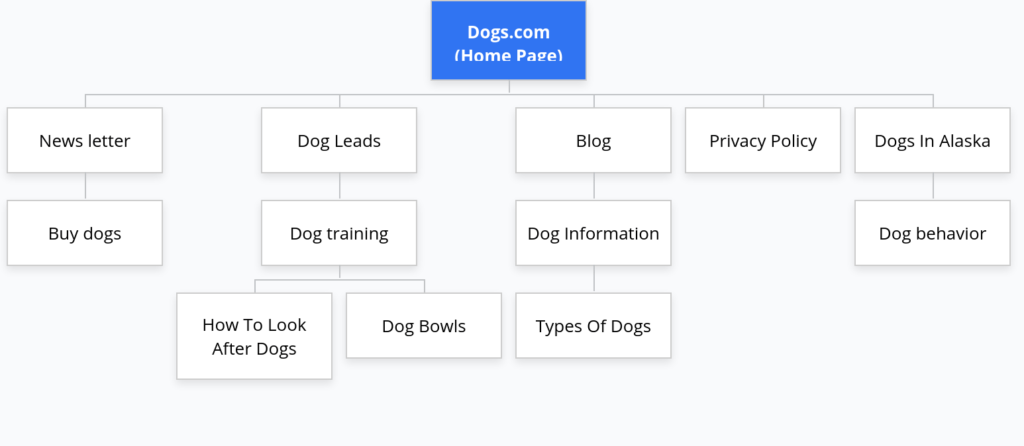Website siloing refers to how a website is structured in regards to its layout and menus. If website siloing is not done correctly your website may be at a disadvantage from the get-go.
Today I am going to share with you my knowledge of what website siloing is and how we can use this to our advantage when creating websites, or to improve the user experience, and SEO of pre-existing websites.
A website silo and its importance is often overlooked but I can assure you, although this is a small subject to cover, the importance of this for SEO and user experience is of utmost importance.
Understanding Website Siloing
Website siloing pertains to the organization and arrangement of a website. From an SEO perspective, mastering this aspect establishes a solid foundation for the site’s future.
By effectively structuring main header pages and supplementing them with supporting content such as blogs, you gain a pivotal advantage in fostering future growth through organic traffic.
Knowing and understanding the overall niche you are in, and the main keywords associated with that niche is the best place to start when constructing a website.
You should also analyze the competition for your chosen niche as well.
From a user experience point of view, if someone cannot find what it is they are looking for on your website, they will leave.
What Is a Website Silo?
A website silo is a layout or map of your website. The layout or silo of a website will tell us 3 important aspects.
These are:
- The pages of your website are in order of rank, starting with the `Home page of the website, then other main menu pages, and so on and so on.
- A website silo will show us which pages are not sitting under the correct category page.
- Most importantly a birds-eye view of how visitors to your website will find the information that they need, and how many steps there are before they find it.
Example Of Bad Website Siloing
For this example, I will build the silo foundation for a website based on the pet niche “Dogs and although this is still very broad, it will be a clear example of how website siloing is used to boost not only SEO rankings, but user experience as well.
The first example for our “Dog website is a bad example of a poorly put-together website for Dogs.
The Home page is Dogs.com, the next 5 pages are the main header pages, usually found in the main menu on the home screen of the website, and underneath these pages are supporting blogs or pages for that main parent page.

Simply put, website siloing refers to the layout and structure of a website, and from an SEO point of view if you nail this correctly, the foundation of your website silo will lay the foundation for the future of that website’s blogs and main niche categories.
Knowing and understanding the overall niche you are in, and the main keywords associated with that niche is the best place to start when constructing your website.
As you can see the website pages are not what people would expect to see when they first land on a dog website.
Pages are not properly categorized into easy-to-find related niche pages are absent, the privacy policy does not need to be on the main header menu and can be inserted into the footer menu instead.
Here is the correct layout for a dog website, remember this example is fairly broad and can be more specific when choosing a more specific main niche.
Example Of Good Website Siloing

As you can see the structure and subcategory pages are what most people would want to see when visiting a “dog website and this is extremely important to keep people on your website.
Remember if people cannot straight away find what they are looking for, or see an easy path to find what it is they want, they will leave.
The supporting pages/blogs are all specifically placed under their specific parent pages.
Knowing and understanding the overall niche you are in, and the main keywords associated with that niche is the best place to start when constructing your website.
Tools For Website Siloing
When embarking on the creation of a new website, it is imperative to conduct thorough research to identify the primary niche keywords and related keywords specific to that particular niche.
This meticulous process serves as the cornerstone for optimizing a website’s visibility and relevance within its target audience.
Jaaxy Keyword Research Tool
In my quest for comprehensive keyword research, I turn to the unparalleled capabilities of Jaaxy, a cutting-edge keyword research tool.
Jaaxy stands out as the epitome of efficiency and accuracy in uncovering niche-specific keywords, providing invaluable insights that empower website creators to make informed decisions about their content strategy.
I wholeheartedly endorse Jaaxy as the go-to solution for anyone engaged in keyword research. Its intuitive interface, advanced features, and real-time data analysis make it an indispensable companion for those seeking to unlock the full potential of their website’s organic reach.
Gloomaps
As you diligently narrow down your list of closely related keywords to your main niche, a supplementary tool comes into play — Gloomaps.
This tool proves to be an invaluable asset, allowing you to visualize the website’s layout even before it takes concrete form.
Gloomaps offers a unique advantage by providing a comprehensive, birds-eye view of the website structure, facilitating the strategic arrangement of content for optimal user experience and SEO performance.
Exploring Gloomaps is a breeze, and you can access its functionalities for free. By utilizing Gloomaps.com, you gain the ability to create a visual representation of any website, helping you fine-tune the layout and structure with precision before committing to the actual development process.
Together, these tools contribute to a strategic and well-informed approach to website development, setting the stage for success in the competitive online landscape.
Website Siloing and User Experience
Just like when we go into any physical store, we want to be able to locate what it is we are after quickly, to make fast efficient use of our time.
People work the same way online, and when users visit a website, niche catogories must be highlighted or made visible to point the user to the right direction

Google Search Console used to measure the retention of a website with a `bounce score.
What this meant is that when people are visiting your website, how long did they stay? Did they leave before they even looked around? Did they leave before the website loaded? Did they visit other pages and read your blogs?
Making sure people can find what it is straight away, or seeing the path to get there straight away the better.
Summary Of Website Siloing and Website Silo
Website siloing referrs to the layout design of a website, which relates back to UX.
By having the correct menu headings and related pages, we know that users or traffic to the website can find easily what it is they are looking for.
By following the examples given in this blog you can design any website with a solid foundation and install the principles of good webisite siloing.





This blog post delves into the critical concept of website siloing and its profound impact on both SEO and user experience. The importance of organizing a website’s structure efficiently cannot be overstated, as it lays the groundwork for enhanced visibility and user engagement.
My question for you is: How do you prioritize between optimizing for SEO and ensuring an intuitive user experience when implementing website siloing strategies? Balancing these two aspects seems crucial for overall website success.
I believe it will do both. UX includes users being able to find what it is they are looking for quickly, so If your main niche Keywords are your menu items, you will have both better UX and SEO rankings.
I fully agree, Finding that happy balance is key…however, I do think they work closely hand in hand 🙂
Hi,
I am new to the affiliate marketing space and am learning as much as I can. I have never heard of website siloing until reading your article. The video was great too, it was like being in a seminar. The graphics put things into perspective. I have begun reassessing my own website structure since reading your article.
thank you.
Bernard
Hi,
I am new to the affiliate marketing space and am learning as much as I can. I have never heard of website siloing until reading your article. The video was great too, it was like being in a seminar. The graphics put things into perspective. I have begun reassessing my own website structure since reading your article.
thank you.
Bernard
Hey, I am glad you found the blog informative 🙂 Website siloing is crucial in getting websites off on the right foot..and I agree it is something that is not often talked about in the website design stage.
Hello and thanks so much for sharing, this is the first that I have heard of this but it is good to know all of what is needed to know when building and managing a website. The information that you have provided will help many people take a more safe approach when it comes to building out a website. Thanks so much for sharing.
You are most welcome!